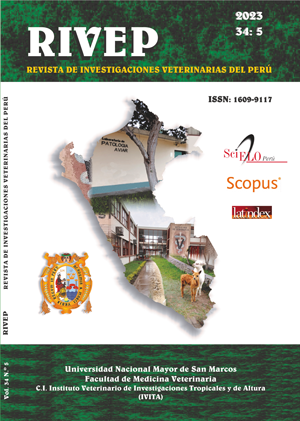Maximization of economic benefits of fattening guinea pig through feed restriction
DOI:
https://doi.org/10.15381/rivep.v34i5.26374Keywords:
profit maximization, guinea pigs, compensatory response, balanced feed, temporary restrictionAbstract
The aim of this study was to evaluate the effect of the temporary restriction of balanced feed on the maximization of the economic benefits of fattening guinea pigs. In total, 100 male and female guinea pigs of the Red Line of 21 ± 3 days of age were used, distributed in 5 metallic cages of 4 levels and 5 animals per cage. The diets of feed restriction were: T1 (ad libitum), T2 (14 days + 50% ration), T3 (21 days + 50% ration), T4 (14 days + 25% ration) and T5 (21 days + 25% ration). The ad libitum ration consisted of 10 g/animal/day with increments of 4 g per week up to a maximum consumption of 66 g/animal/day. Green alfalfa was supplied in a proportion equivalent to 10% of body weight. By using body weights, weekly feed consumption and unit prices, growth functions (S), production (Q) and accumulated economic benefits (B) were established. The first partial derivative was applied to B to obtain profit maximization values (BMax), whose conjugation with Q and S, allowed estimating body weights (QMax) and maximum fattening times (SMax) of the experimental groups. The results showed a better compensatory response in male guinea pigs and a higher BMax in T4 compared to T1 (control), with the disadvantage of requiring higher SMax, but which is favourable for achieving higher QMax. It is concluded that a restriction level of 25% of the daily ration for 14 days is appropriate to maximize the economic benefits of male and female guinea pigs.
Downloads
Downloads
Published
Issue
Section
License
Copyright (c) 2023 Elmer Meza, Javier Orellana, Luis Astuhuamán, Gilmar Mendoza

This work is licensed under a Creative Commons Attribution 4.0 International License.
AUTHORS RETAIN THEIR RIGHTS:
a. Authors retain their trade mark rights and patent, and also on any process or procedure described in the article.
b. Authors retain their right to share, copy, distribute, perform and publicly communicate their article (eg, to place their article in an institutional repository or publish it in a book), with an acknowledgment of its initial publication in the Revista de Investigaciones Veterinarias del Perú (RIVEP).
c. Authors retain theirs right to make a subsequent publication of their work, to use the article or any part thereof (eg a compilation of his papers, lecture notes, thesis, or a book), always indicating the source of publication (the originator of the work, journal, volume, number and date).










